
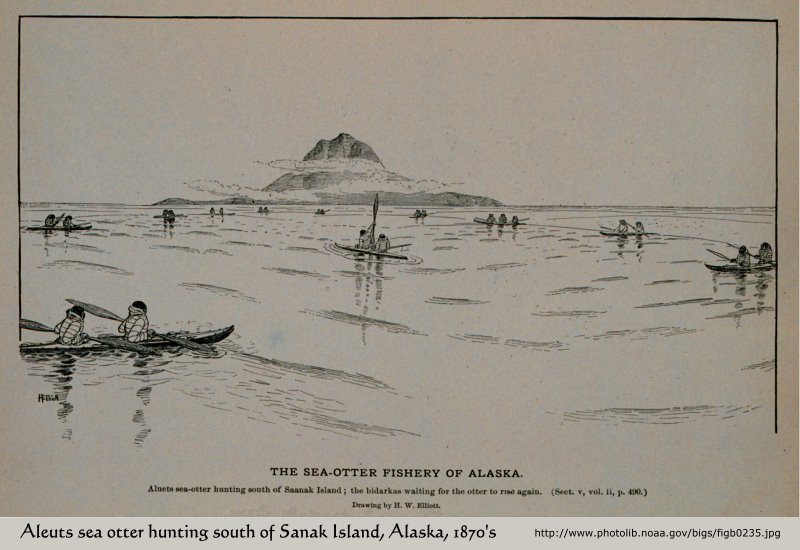
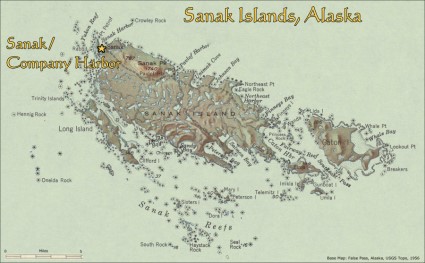
Click on map for larger version.
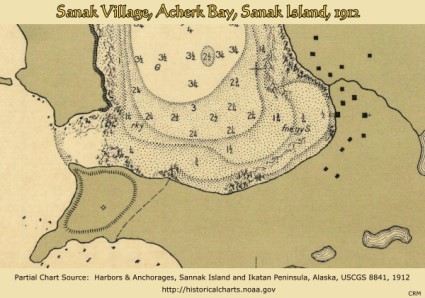
Sanak / Company Harbor is located on the northwest end of Sanak Island. The village was called Sanak in Aleut and Russian times and some time before 1893, the name "Company Harbor" was often used in English, probably to reflect the presence of the Alaska Commercial Company that established a trading station there and took over the fur trading business from the Russian American Company.3 The spelling of the name of Sanak varied from Sanakhak and Sannakh in transliterated Russian1 to Sanaĝax or Sanax in the Aleut language script.2 The "x" in Aleut script usually has a circumflex over it, "^", and is pronounced roughly "kh" in English. Sanak was sometimes rendered as Sannak or Sannack in English.
Sanak Island is mostly a low island with many lakes and marshes and numerous rocks and reefs close to shore. The fishing banks surrounding the island are some of the richest in Alaska. The highest point on the island is Sanak Peak at 1740 ft/530 m. Sanak Island is about 14 miles southeast of the tip of the Ikatan Peninsula, Unimak Island.
The Sanak Corporation, an Alaska Native Claims Settlement Act (ANCSA) corporation, now owns all the land and cattle on Sanak Island and it has its office in Sand Point.* The cultural and social services for the shareholders of Sanak Corporation are provided by the non-profit Pauloff Harbor Tribe with a presence in Sand Point, AK.*
"Sanak (Acherk) Harbor at the northwest end of Sanak Island, is 3/4 mile long and about 1/4 mile wide, and affords a contracted anchorage for small vessels with protection from southerly and westerly winds, but is exposed to winds from the northwest to east, and a swell makes in with strong westerly winds. There is a small settlement at the southeast corner of the harbor, at which there is a boat landing, and water can be obtained by boats...."4
The 1912 chart above shows the distribution of buildings in Sanak village at around that time. There is an interesting square symbol on the site of the old village of Sanax (Sanak), indicating a structure there, perhaps dating from the Russian period. This could be the location of the Russian American building but no excavation has been carried on there to find out. There is also a trail leading across the point. The chart shows the modern village of Sanak (Company Harbor) built when companies had commercial ventures there requiring sailing ships, docks and warehouses. The church is shown as well as the boat landing area and 15 other structures. The Russian Orthodox church was built in 1882. The U.S. post office was established in 1909 with the name of Sanak and was closed in 1953, years after the codfish station there closed.5,7 The 1900 & 1910 U.S. Census used "Sanak" as the name of the community, whereas the 1920 & 1930 Census used "Company Harbor" as the name of the community.
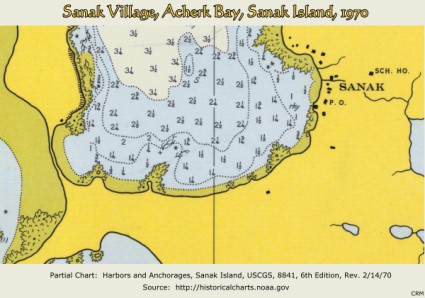
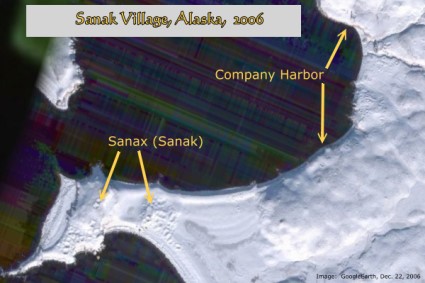
Sanak/Company Harbor during the early American period was used primarily for a sea otter hunting base. "The Alaska Commercial Company and some of its rivals have been in the habit of carrying hunting parties to Sannak for many years from all the settlements of the Aleutian Islands. On the northwestern end of the island, in a small cove, they have a permanent trading station, stocked only to supply the immediate wants of the hunters, and also comfortable quarters for such natives as are willing to exchange the free and easy but uncertain shelter of their tents for the restraint of bunks in tiers under a solid roof. During the summer the coasts of the island are still white with tents. Although the island of Sannak has no permanent inhabitants except the storekeeper and agents of the fishing and trading companies, over 100 hunters and fishermen were enumerated here in 1890. Several white sea-otter hunters have erected houses on small outlying islands, which they occupy during the hunting season with their families. The reefs which surround Sannak, and which extend their dangerous network about 30 miles in width northward nearly to the Shumagin Islands, have been considered the most important sea-otter ground of Alaska."8
The Alaska Commercial Co. abandoned its station in Sanak/Company Harbor by 1897.15
Codfish stations were established at Sanak in the late 19th century. "In 1876 Mr. A. Greenebaum, then and for a number of years subsequent, agent for the Alaska Commercial Co., built a trading station for the company at Acherk Harbor (later known as Company Harbor) on Sannak Island. A little codfish was prosecuted at times, but it was not until 1896, when it became the property of the progenitors of the Alaska Codfish Co., that it was used for this business exclusively. In 1897 the company established another station on Moffet Cove, a few miles east of Company Harbor."9
Shore station fishing, handling and salting of cod is described in detail here.
Company Harbor in 1913 can be seen in photographs here & here.
The Aleut village of Sanax (Sanakh or Sanak) was established at some remote time by the Aleut people. Sanak Island has an archeological record of Aleut occupancy of about 6,000 years.14 According to Veniaminoff, in pre-Russian times Sanak Island had several small villages, but none of them were very large. During Russian times, there were apparently two larger villages and Sanak village was certainly one of them because Sanak was the center for sea otter hunting.5 Traces of Aleut barabara house pits of the original Sanax can be seen on the point of land in the above space shuttle picture. The building traces on the modern village of Company Harbor can be seen along the beach on the upper right and these traces roughly match the buildings shown on the chart to the left. In 1807, Archibald Campbell was a crewman on the American sailing vessel Eclipse which shipwrecked on Sanak Island and he reports that: "There is a village of 12 or 15 Indian families at the northern extremity of the island. These people are under the government of the Russians, for whom they provide furs for the <Russian> American Company. They are a quite inoffensive race, converts to the Greek Church....."6
Archeological work on Sanak Island has recently been done by Herbert Maschner and colleagues. The team has focused on the biocomplexity of Sanak Island by studying old Aleut village middens and comparing their composition to present marine life conditions. Their report is the most comprehensive study of this type done in the Aleutian area. Their systems approach aids our understanding of the Aleutian Ecosystem and the Aleut's vital part in it. A review copy of their work can be found here.
All the people on Sanak Island were moved to Belkofski Bay on the Alaska Peninsula by the Russian American Company in 1823, where the new settlement of Belkofski was created.5 People returned from Belkofski to settle on Sanak Island to hunt sea otters under the American administation. In 1876 the first of the codfish stations was established and the cod era began.
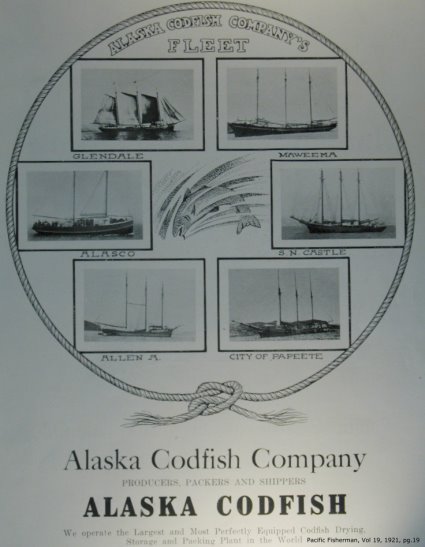
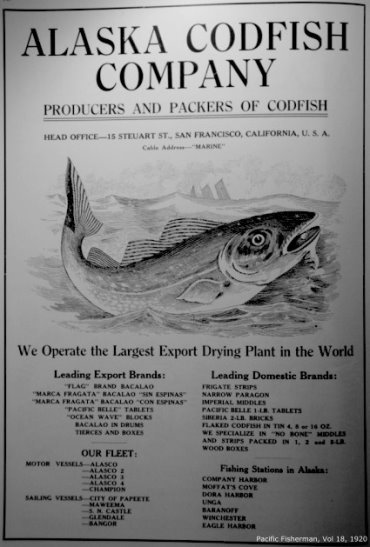
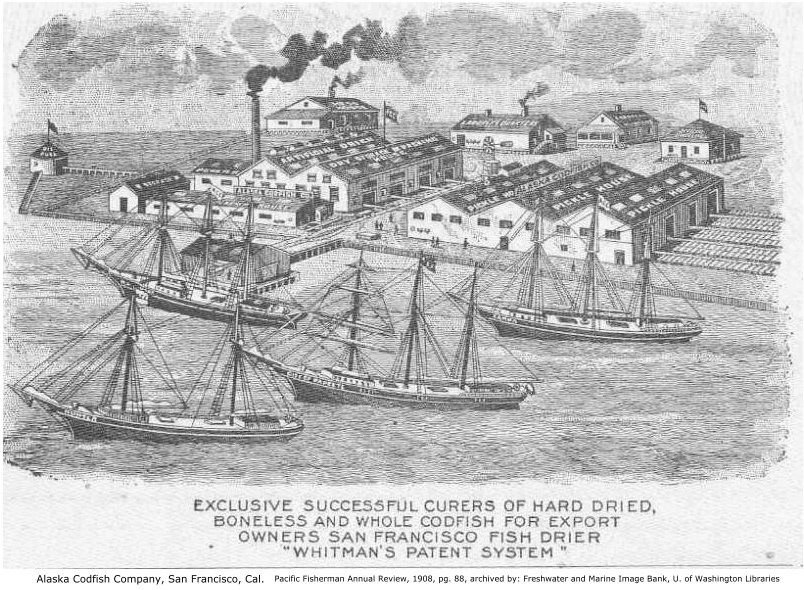
An overview of San Francisco's involvement in the Alaska codfish business can be read here.
The Sanak/Company Harbor population data begins with a general census made in 1890. At that time, 23 years after the new American administration of Alaska began, the emphasis was on sea otter hunting and cod fishing. There is no occupation data available for 1890, but because of the historical context, it can be assumed that the population is relatively high because of the lucrative business of harvesting sea otters.
The sea otter population was heavily over exploited and by 1900 the harvest dropped dramatically. Fortunately for the local workers in Sanak, there was already a codfishing station established that helped stabilize the population through 1920. Then the codfish stocks began to decline throughout the prime fishing areas on the Sanak Banks in the late 1930s and all the codfishing stations closed.
During the summer salmon season, some fishermen began to prepare salt salmon in barrels for shipment to Seattle. Slowly, the Sanak fishermen began to get their own salmon fishing boats and began to deliver their catch to the canneries located at False Pass, Ikatan and King Cove, while maintaining their residence in Sanak. Some of these fishermen would have to spend their season away from Sanak because the most productive salmon fishing areas were on the Alaska Peninsula.
In the wintertime some men began trapping fox and other fur-bearing land animals, mostly on Unimak Island and the Alaska Peninsula. Fox farming on small nearby islands also occupied several families during the period. No occupation census data for 1940 has yet been released. The last year a census was taken was 1940. Sanak/Company Harbor was finally abandoned around 1953.
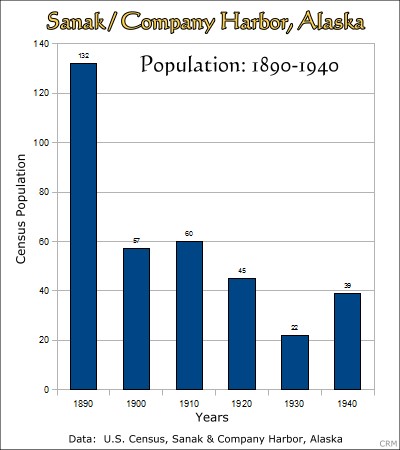
The population size of Sanak/Company Harbor during the American period was heavily influenced by the intense effort to harvest sea otters under the American administration. For centuries the Aleut people had harvested sea otters in such a manner that their numbers were not pushed towards extinction and a sustainable harvest was achieved. Then, under the Russian administration as the pressure to harvest sea otters for the export trade increased and sea otter numbers declined, the Russians understood that controls would have to be put into place to protect them. Therefore, in 1823, they removed all residents from the Sanak Islands and from those people, created the village of Belkofski on the Alaska Peninsula. When the Americans took over the administration of Alaska, poaching of sea otters and fur seals was rampant and the U.S. government sent in Revenue Cutters to help control the illegal harvest. Rules were used that limited sea otter hunting to only Aleuts but American immigrant men could marry Aleut women to gain rights to harvest the otters. The hunting activity was so intense that by the time an international treaty banning the hunting of sea otters was passed in 1910, the sea otters around Sanak had been exterminated."In 1910 the last sea otter hunt was conducted in 12 two-hatch baidarkas.”11
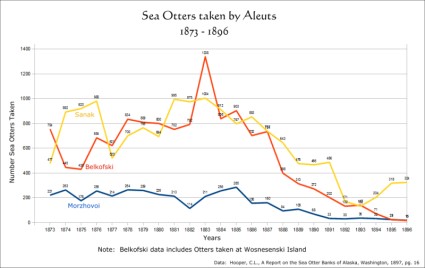
Click on graph to see larger version.
The 1900 census data for Sanak/Company Harbor shows the essential character of the village. The Alaska Codfish Co. had its agent here and a small staff to support the fishing operation. Since this was a codfish shore station, the fishermen lived ashore and went out to fish in dories daily. Upon return to port, the fishermen then helped with the salting of the catch of that day. The three seamen worked for the codfish company and called San Francisco their home, but is isn't clear exactly what they did.
At this date there was still some sea otter hunting taking place. The hunters are all Aleut and it isn't clear how the hunt was organized because the traditional Aleut way of hunting usually requires about 10 kayaks. At this date, there was a high proportion of foreign born men, some who became permanent residents. Sanak had a large enough population to support a Russian Orthodox priest by the name of David Nedurazoff, who had a wife Alexandria and a son, Lazaras, who was a hunter.
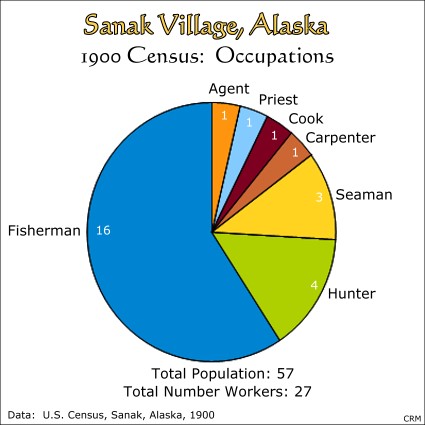
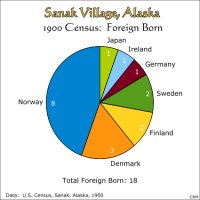
The 1910 census data for Sanak/Company Harbor show that fishing was the primary source of employment. The Alaska Codfish Company was in operation and the resident fishermen went out in dories to catch cod to bring back to the shore station for processing. Apparently some of these fishermen would travel to the company's Dora Harbor station on the Ikatan Peninsula for summer fishing for cod in deeper waters. Then, they would return to Sanak in the fall to fish on the Sanak grounds where cod were again plentiful.
By 1910 sea otter hunting was history. A few men called themselves hunters and they also said they were trappers. Since there are no large animals on Sanak, these men probably hunted some of the larger fur-bearing animals on Unimak Island and the Alaska Peninsula and also trapped for fox there.
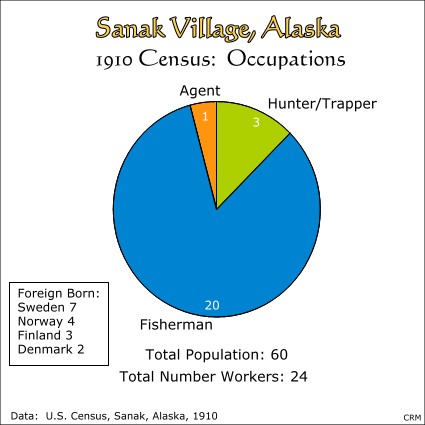
 Alaska Codfish Co. deliveries to San Francisco in 1916.
Alaska Codfish Co. deliveries to San Francisco in 1916.
The 1920 Sanak/Company Harbor census data show that the codfishing business was still providing economic stability to the community. Around this time, fox farming was started on small islands near the main island of Sanak. These small islands were also sea bird nesting sites and the foxes thereby had a relatively stable food supply on the eggs and nestlings and they could forage on the beach.13
Several different individuals introduced domesticated cattle to Sanak. Many of these cattle have since gone wild and roam the countryside of Sanak. They are able to survive the usually mild Aleutian winters feeding on dry grasses and by descending to the beach to forage on kelp. These cattle now belong to the Sanak Corporation.13
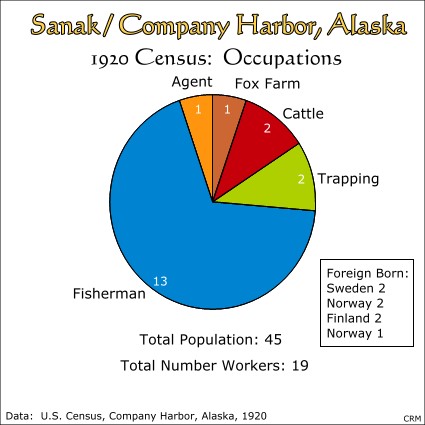
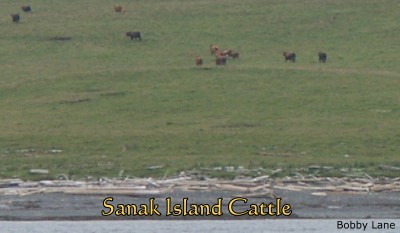
The 1930 Sanak/Company Harbor census data show that local workers had now concentrated upon just fishing to gain a living. Most of this fishing effort was for codfish, but since salmon were available locally and a market existed for salt salmon, salted salmon were put up in wooden barrels, mostly at the head of Salmon Bay on the south end of the island. Salt salmon could be prepared by using a very simple technology and a minimum of expenditure. Salmon also appeared in the summer, when codfish were absent.13
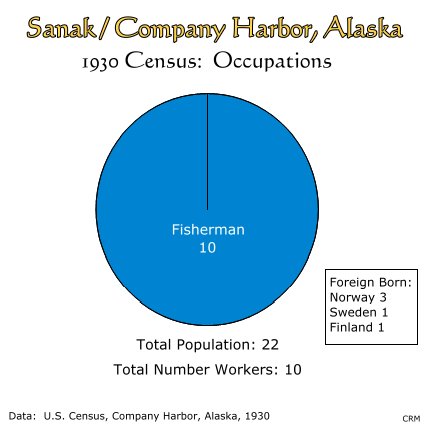
In 1932, the salt salmon pack for Sanak was reported as:
P.W. Nielsen: 75 barrels
John Olsen: 48 barrels
Ben Mobeck: 43 barrels
A. Carlson: 65 barrels12
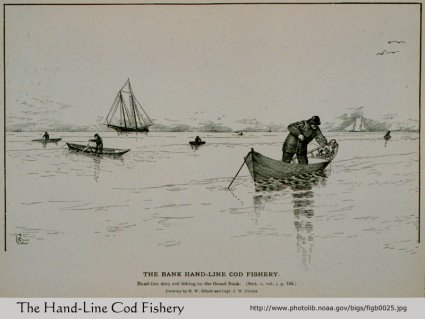
Cod fishing technology around Sanak was brought in from the East Coast where cod fishing had a long tradition. The Scandinavian immigrants also brought with them the cod fishing technology that they knew from the old country. Hand fishing lines were used from dories. But, on Sanak Island, instead of mother ships (as seen in the sketch above), the dorymen returned to the shore station every evening to deliver their catch. Schooner codfishing and processing that did not need shore stations was also common in the waters near Sanak. This schooner fishery had its headquarters mostly in the Seattle area.
The 1940 U.S. Census for Sanak lists only "Sanak" for the village name and does not mention Company Harbor. The total population increased from 22 to 39 over the ten year period. As in 1930, the occupations were exclusively in the fishing industry. Since codfish had disappeared, the fishermen fished for salmon. Some of these fishermen had boats and actually delivered their fish to the False Pass cannery. However, the greatest number of fishermen fished for salmon and salted them in wooden barrels for shipment to Seattle, mostly to the Bunsen & Davis brokerage house. The most prized species of salmon for salting was red or sockeye, but silvers (coho) were also salted during the fall run. There was a local run of red salmon into a lake at the south end of Sanak Island at Salmon Bay."In dressing salmon for pickling (salting) the heads are removed, the fish split along the belly, the cut ending with a downward curve on the tail. The viscera and two-thirds of the backbone are removed, and the blood, gurry, and black stomach membrane scraped away. The fish are then thoroughly scrubbed and washed in cold water. They are next placed in pickling butts with about 15 pounds of salt to every 100 pounds of fish. The fish remain here about one week, when they are removed, rubbed clean with a scrub brush, and repacked in market barrels, one sack of salt being used to every three barrels of 200 pounds each. About 40 to 52 red salmon, 25 to 35 coho salmon, 70 to 80 humpback salmon, 10 to 14 king salmon, and 25 to 30 dog salmon are required in packing a barrel of pickled salmon."16
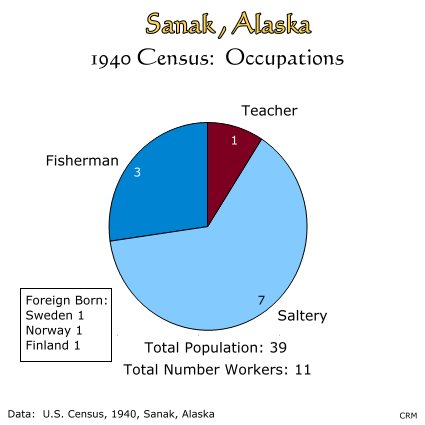
References:
*) Sanak Corporation, P.O. Box 194, Sand Point, AK 99661, Phone 907-383-6075, Fax 907-383-5233
1) See the old Russian maps on the "Isanotski Strait" page of this website (False Pass/Isanotski Strait)
2) Wikipedia entry for "Sanak Island"
3) U.S. Census, Company Harbor, Alaska, 1920.
4) U.S. Coast Pilot, USGPO, 1926
5) Black, Lydia T., History and Ethnohistory of the Aleutians East Borough, Limestone Press, 1999. pg. 60
6) Archibald Campbell, A voyage round the world: from 1806 to 1812, in which Japan, Kamschatka, the Aleutian Islands, and the Sandwich Islands, Broderick and Ritter, 1819, Chapter III, pg. 37 (Google Books)
7) Ricks, 1965, p. 56
8) United States Congressional serial set, Issue 3056, USGPO, 1893 (Google eBook), pg.87
9) Cobb, John Nathan; Pacific Cod Fisheries, "History of Alaska Shore Fishing Stations", Gov. Printing Office, 1916, pg. 38, Google Books
10) Pacific Fisherman, Vol 19, 1921
11) Turek, Mike, "Traditional Uses of Steller Sea Lions.", Alaska Fish & Wildlife News, October, 2007
12) Pacific Fisherman, Statistical Yearbook, vol. 31, 1933.
13) Interviews with Chris and Emil Gundersen.
14) Maschner, Herbert et al., "An Introduction to the Biocomplexity of Sanak Island, Western Gulf of Alaska, Pacific Science, vol. 63, No. 4, 2009, pg. 674.
15) Hubert, Philip Gengembre "Making of America Project" The Atlantic Monthly, vol 82, 1898, pg. 580 (Google eBook)
16) Cobb, John Nathan, The Salmon Fisheries of the Pacific Coast, Bureau of Fisheries 751, GPO, 1911, pg. 62 (Google eBook)